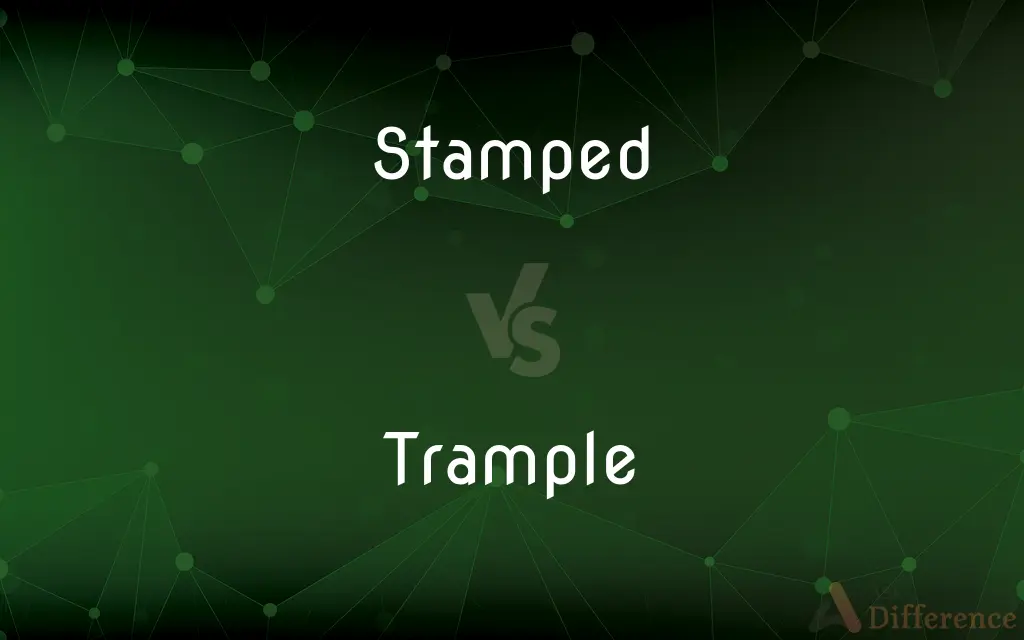Stamped vs. Trample — What's the Difference?
Edited by Tayyaba Rehman — By Urooj Arif — Updated on March 27, 2024
"Stamped" implies a forceful stepping or pressing down, often with a foot or tool, while "trample" involves stepping heavily and repeatedly on something or someone, causing damage or injury.

Difference Between Stamped and Trample
Table of Contents
ADVERTISEMENT
Key Differences
Stamped is often used to describe a deliberate action of pressing down with a foot, hand, or tool, leaving an impression or mark, such as in stamping a document for approval or creating a pattern. It conveys a single or series of forceful actions with a specific purpose, such as validating, marking, or decorating. Trample, on the other hand, denotes a more chaotic or aggressive action of walking or stamping on something or someone so forcefully and repeatedly that it causes harm, damage, or destruction. This term is frequently used to describe what happens in a crowd situation or by animals in a stampede.
The context of "stamped" often involves intent and control; the action is measured and has a clear purpose behind it. For example, stamping a letter with a seal to authenticate it involves precision and intention. Trample, conversely, implies a lack of control and is often associated with disregard for the object or person being stepped on. The action is not only about contact but about the impact of that contact, highlighting a destructive or harmful outcome.
In usage, "stamped" can be applied both in literal and metaphorical contexts. Literally, it might refer to the act of using a stamp on paper, or metaphorically, it might describe someone imposing their authority or approval. "Trample" is also used in both senses but conveys a stronger sense of disrespect or damage in its metaphorical use, such as trampling on someone's rights or dignity, indicating an abuse or overstepping of boundaries.
The implications of "stamped" can be neutral or positive, depending on the context—stamping a passport is part of a standard procedure, while stamping a design into clay is an act of creation. The implications of "trample" are predominantly negative, associated with disrespect, disregard, or violence—trampling a garden shows negligence or intentional harm, and trampling over people’s feelings shows insensitivity or cruelty.
Both "stamped" and "trample" reflect the impact of forceful actions, but they diverge significantly in their intent, control, and outcomes. Stamped actions are about making a mark with purpose and precision, while trample actions are about causing damage or harm through forceful, often reckless, movements.
ADVERTISEMENT
Comparison Chart
Definition
Pressing down forcefully to make an impression.
Stepping heavily and repeatedly causing damage.
Intent
Purposeful, with a specific goal.
Often chaotic, with potential harm.
Control
Measured, controlled action.
Lack of control, aggressive.
Context
Can be literal or metaphorical, neutral/positive.
Usually negative, implying damage or disrespect.
Outcome
Creation of a mark, validation, decoration.
Destruction, harm, disrespect.
Compare with Definitions
Stamped
Making an Impression.
She stamped the clay with a patterned tool to add texture.
Trample
Causing Damage by Stepping.
The excited crowd trampled the grass into the mud.
Stamped
Decorative Purpose.
They stamped the invitations with a unique seal.
Trample
Ignoring or Disrespecting.
The company’s decision trampled on employee rights.
Stamped
Metaphorical Use.
His actions stamped a lasting impression on the community.
Trample
Metaphorical Use.
The politician’s rhetoric trampled on the principles of fairness.
Stamped
Validating or Approving.
The officer stamped my passport, allowing me entry.
Trample
Repeated Heavy Stepping.
The horses trampled the fallen leaves on the path.
Stamped
Imposing Authority.
The new policy was stamped with the CEO’s approval.
Trample
Resulting in Harm or Destruction.
Vandals trampled the flowerbeds overnight.
Stamped
To bring down (the foot) forcibly.
Trample
To beat down with the feet so as to crush, bruise, or destroy; tramp on.
Stamped
Stamped is an iPhone app launched by a team of (mostly) former Google employees in November 2011 that keeps track and shares users' recommendations for restaurants, music, books, etc. on social media.
Trample
To treat harshly or ruthlessly
Would trample anyone who got in their way.
Stamped
To bring the foot down onto (an object or surface) forcibly.
Trample
To tread heavily or destructively
Trampling on the flowers.
Stamped
To cause to be dislodged by stomping the feet
He stamped the snow from his boots.
Trample
To inflict injury as if by treading heavily
"trampling on the feelings of those about you" (Thornton Wilder).
Stamped
To subdue, destroy, or eliminate
Stamped the rebellion.
Stamp out a fire.
Trample
The action or sound of trampling.
Stamped
To crush or grind with a heavy instrument
Stamp ore.
Trample
(transitive) To crush something by walking on it.
To trample grass or flowers
Stamped
To form or cut out by application of a mold, form, or die
Washers that were stamped from a piece of sheet metal.
Trample
(by extension) To treat someone harshly.
Stamped
To imprint or impress with a mark, design, or seal
Stamp a passport.
Trample
(intransitive) To walk heavily and destructively.
Stamped
To impress forcibly or permanently
An experience that was stamped on his memory.
Trample
(by extension) To cause emotional injury as if by trampling.
Stamped
To affix an adhesive stamp to (an envelope, for example).
Trample
A heavy stepping.
Stamped
To identify, characterize, or reveal
Stamped her as a traitor to the cause.
Trample
The sound of heavy footsteps.
Stamped
To thrust the foot forcibly downward
Stamp on the brake pedal.
Trample
To tread under foot; to tread down; to prostrate by treading; as, to trample grass or flowers.
Neither cast ye your pearls before swine, lest they trample them under their feet.
Stamped
To walk with forcible, heavy steps.
Trample
Fig.: To treat with contempt and insult.
Stamped
The act of stamping.
Trample
To tread with force and rapidity; to stamp.
Stamped
An implement or device used to impress, cut out, or shape something to which it is applied.
Trample
To tread in contempt; - with on or upon.
Diogenes trampled on Plato's pride with greater of his own.
Stamped
An impression or shape formed by such an implement or device.
Trample
The act of treading under foot; also, the sound produced by trampling.
The huddling trample of a drove of sheep.
Stamped
An official mark, design, or seal that indicates ownership, approval, completion, or the payment of a tax.
Trample
The sound of heavy treading or stomping;
He heard the trample of many feet
Stamped
A small piece of gummed paper sold by a government for attachment to an article that is to be mailed; a postage stamp.
Trample
Tread or stomp heavily or roughly;
The soldiers trampled across the fields
Stamped
A similar piece of gummed paper issued for a specific purpose
Trading stamps.
Trample
Injure by trampling or as if by trampling;
The passerby was trampled by an elephant
Stamped
An identifying or characterizing mark or impression
His work bears the stamp of genius.
Trample
Walk on and flatten;
Tramp down the grass
Trample the flowers
Stamped
Characteristic nature or quality
A person of her stamp.
Stamped
Simple past tense and past participle of stamp
Stamped
Marked with the impression of a seal
Common Curiosities
Can the term "stamped" have positive connotations?
Yes, "stamped" can have positive connotations, such as when it refers to artistic creation or the validation of documents.
Is stamping always a physical action?
Stamping can be both a physical action and a metaphorical concept, such as stamping approval or authority in a non-physical sense.
Why is trampling considered negative?
Trampling is considered negative because it implies harm, disrespect, or destruction towards others or their property.
Can trample be used in a positive context?
"Trample" is predominantly used in negative contexts due to its associations with damage and disregard, though creatively, it could be used positively in rare cases to denote overcoming or surpassing obstacles.
Can animals trample?
Yes, animals, especially in groups or when frightened, can trample vegetation, ground, or even people, causing damage or injury.
What does it mean to stamp something?
To stamp something means to press down forcefully to make an impression or mark, often for validation, decoration, or approval.
What are the implications of trampling on rights?
Trampling on rights implies a serious violation or disregard for someone’s freedoms or entitlements, often leading to legal and ethical issues.
How is trampling different from just walking?
Trampling involves walking or stepping on something with enough force to cause damage or injury, unlike regular walking which is generally harmless.
Is there a way to prevent being metaphorically trampled?
Preventing metaphorical trampling involves asserting rights, setting clear boundaries, and sometimes legal action to protect those rights and boundaries.
How does context affect the interpretation of "stamped" and "trample"?
Context significantly affects interpretation; "stamped" can range from bureaucratic to creative, while "trample" generally moves from physically damaging to metaphorically oppressive.
Share Your Discovery

Previous Comparison
Basic vs. Elementary
Next Comparison
Postcard vs. EmailAuthor Spotlight
Written by
Urooj ArifUrooj is a skilled content writer at Ask Difference, known for her exceptional ability to simplify complex topics into engaging and informative content. With a passion for research and a flair for clear, concise writing, she consistently delivers articles that resonate with our diverse audience.
Edited by
Tayyaba RehmanTayyaba Rehman is a distinguished writer, currently serving as a primary contributor to askdifference.com. As a researcher in semantics and etymology, Tayyaba's passion for the complexity of languages and their distinctions has found a perfect home on the platform. Tayyaba delves into the intricacies of language, distinguishing between commonly confused words and phrases, thereby providing clarity for readers worldwide.
















































